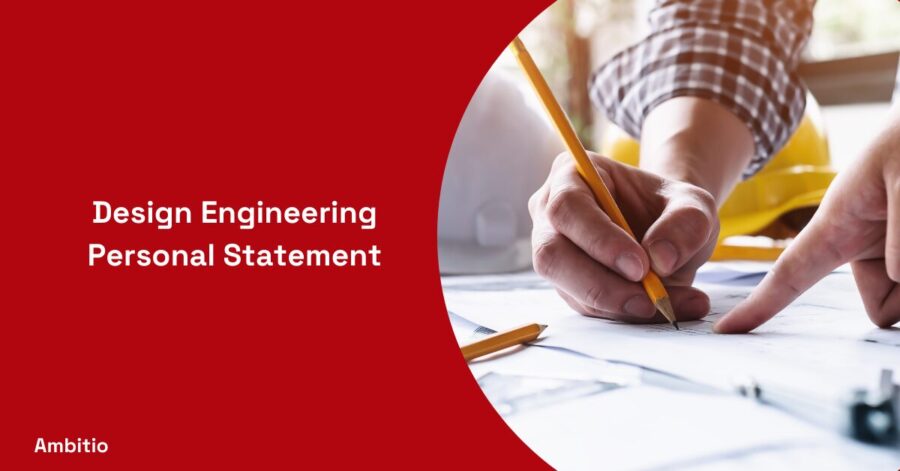11 December 2024
5 minutes read
Design Engineering Personal Statement: Crafting Your Path in Engineering

Introduction: Embracing the World of Design Engineering
Design engineering stands at the confluence of innovation, creativity, and technical expertise. As a prospective student or professional ready to delve into this exciting field, your personal statement is a crucial element of your application, whether it’s for university admission or a job position.
It’s more than a formal document; it’s a narrative of your passion, skills, and aspirations in design engineering.
Understanding the Essence of a Personal Statement
The personal statement is a unique opportunity to convey your enthusiasm for design engineering. It’s your chance to demonstrate not only your academic achievements and technical skills but also your personal journey, interests, and motivations driving you toward a career in design engineering.
Crafting a Narrative That Resonates
Your statement should tell a story – your story. Begin with an engaging opening that captures your initial interest in design engineering. Was it a childhood fascination with gadgets, an influential figure, or a particular event that ignited your passion?
Detailing this personal journey adds depth and relatability to your statement.
Balancing Academic and Personal Insights
While highlighting your academic achievements is crucial, balancing them with personal experiences makes your statement well-rounded. Discuss projects, internships, or any relevant work experience that has shaped your understanding of design engineering.
Remember, admissions panels and employers are looking for candidates who bring both technical knowledge and real-world insights.
Demonstrating Your Technical Proficiency and Passion
Your personal statement should reflect a strong foundation in relevant subjects like mathematics, physics, and design technology. This section is where you showcase your technical abilities and how they align with your passion for design engineering.
Showcasing Academic Achievements
Discuss your academic journey, focusing on subjects that have strengthened your foundation in engineering principles. Highlight any particular coursework, research, or projects that have honed your skills in design engineering.
Revealing Your Passion Through Projects
Elaborate on specific projects or competitions you’ve participated in. Whether it’s a coding challenge, a design competition, or a collaborative project, these experiences demonstrate your practical skills and your ability to apply theoretical knowledge in real-world scenarios.
The Role of Extracurricular Activities and Work Experience
Extracurricular activities and work experience play a vital role in shaping your profile as a well-rounded candidate. They provide insights into your ability to apply your skills outside the classroom and your commitment to the field.
Leveraging Extracurricular Activities
Discuss how activities outside of academics have contributed to your growth. Participation in clubs, societies, or events like the Duke of Edinburgh award can reflect leadership, teamwork, and other valuable skills relevant to a career in design engineering.
Gaining Real-World Experience
If you have had the opportunity to intern or work in a relevant field, detail these experiences. They provide credibility to your understanding of the industry and demonstrate your initiative in gaining practical exposure.
Articulating Long-Term Goals and Aspirations
A compelling personal statement should also outline your future aspirations. This section is your chance to discuss where you see yourself in the future and how your education and experiences will help you achieve these goals.
Envisioning Your Future in Design Engineering
Share your long-term professional goals. Whether you aspire to innovate in product design, contribute to sustainable engineering solutions, or lead technological advancements, articulating these aspirations shows clarity of purpose and ambition.
How This Course or Position Fits Into Your Plans
Explain how the course or position you are applying for aligns with your long-term objectives. This alignment demonstrates that you have thoughtfully considered your decision and are committed to a path that furthers your goals.
Addressing Challenges and Learning Experiences
In the journey towards a career in design engineering, facing and overcoming challenges is a crucial part of personal and professional development. Here are key points to consider when addressing challenges and learning experiences in your design engineering personal statement:
- Identifying Specific Challenges:
- Describe specific obstacles you’ve encountered in your educational or professional journey.
- These could range from mastering complex concepts in design and engineering courses to handling demanding projects or internships.
- Demonstrating Problem-Solving Skills:
- Explain how you approached and solved these challenges.
- Emphasize your analytical and problem-solving skills, showcasing how you applied them in practical scenarios.
- Learning from Setbacks:
- Reflect on what these challenges taught you.
- Discuss the lessons learned and how they contributed to your growth as a design engineer.
- Adapting to New Situations:
- Highlight your ability to adapt to changing circumstances, whether in academic settings or during internships.
- Show how flexibility and adaptability are part of your approach to design engineering.
- Developing Resilience:
- Illustrate how facing challenges has built your resilience.
- Mention how this resilience has prepared you for the demanding and ever-evolving field of design engineering.
- Applying Theoretical Knowledge to Real-World Problems:
- Discuss instances where you had to apply your theoretical knowledge from courses to solve real-world design problems.
- This could include projects, workshops, or extracurricular activities related to design engineering.
- Enhancing Teamwork and Communication Skills:
- Many engineering challenges require teamwork.
- Share experiences where working with others helped you overcome obstacles, highlig
- Embracing Continuous Learning:
- Emphasize your commitment to continuous learning and improvement.
- Show how each challenge has been an opportunity to learn something new and improve your skills.
- Seeking Feedback and Mentorship:
- Mention how you sought feedback from professors, peers, or professionals in the field.
- Describe how mentorship or guidance helped you navigate and overcome challenges.
- Balancing Academic and Personal Responsibilities:
- If applicable, discuss how you managed to balance demanding academic responsibilities with personal commitments.
- This can demonstrate your time management and organizational skills.
- Setting Goals and Achieving Milestones:
- Outline how overcoming these challenges has helped you set clearer goals and achieve significant milestones in your journey toward a career in design engineering.
- Outline how overcoming these challenges has helped you set clearer goals and achieve significant milestones in your journey toward a career in design engineering.
- Preparing for Future Challenges:
- Conclude by stating how these experiences have equipped you to face future challenges in your academic and professional career in design engineering.
- Conclude by stating how these experiences have equipped you to face future challenges in your academic and professional career in design engineering.
Incorporating these points into your personal statement can effectively showcase how your experiences with challenges have shaped you into a more skilled, resilient, and adaptable design engineer, ready to contribute meaningfully to the field.
Concluding with a Strong, Forward-Looking Statement
The conclusion of your personal statement should be impactful, leaving a lasting impression on the reader. It’s your final opportunity to reinforce your passion, commitment, and suitability for a career in design engineering.
Reinforcing Your Passion and Commitment
Reiterate your enthusiasm for design engineering and your readiness to contribute to the field. Highlight your unique qualities and experiences that make you an ideal candidate for the course or position.
Looking Ahead with Optimism and Determination
Conclude with a forward-looking statement that reflects optimism and determination. Express your eagerness to embark on this next phase of your journey in design engineering, whether it’s furthering your education or starting your professional career.
Conclusion: Crafting a Memorable Design Engineering Personal Statement
Writing a compelling design engineering personal statement is an art that requires introspection, clarity, and a genuine portrayal of your journey and aspirations.
It’s your personal narrative that demonstrates not just your qualifications, but your passion, your experiences, and your vision for the future in the field of design engineering.
By carefully constructing your statement with these elements, you set the stage for a promising journey in this dynamic and ever-evolving field.
FAQs
Q1: How long should my engineering personal statement be?
A: Typically, UCAS statements should be up to 4,000 characters, including spaces.
Q2: Can I include experiences outside of school?
Absolutely. Any experience, like the Bronze Duke of Edinburgh or other extracurricular activities, can demonstrate valuable skills.
Q3: Should I mention specific engineering fields in my statement?
Yes, if you have a specific interest, such as structural and mechanical engineering or product design, mention it to show direction in your studies.
Q4: How can I make my personal statement stand out?
Focus on unique experiences, personal insights, and specific goals to make your statement memorable. Show your passion and how it drives your desire to pursue engineering.

You can study at top universities worldwide!
Get expert tips and tricks to get into top universities with a free expert session.
Book Your Free 30-Minute Session Now! Book a call now




























